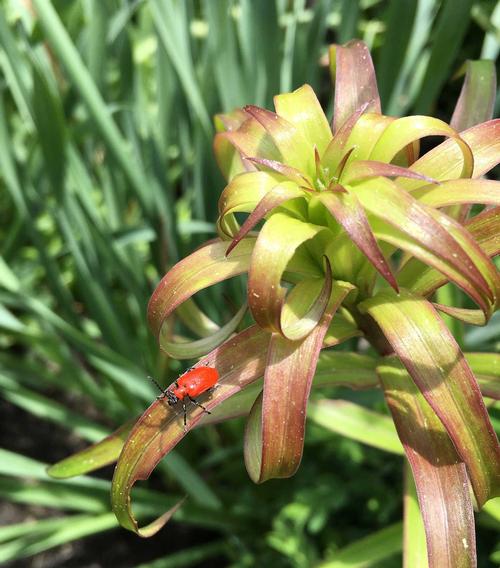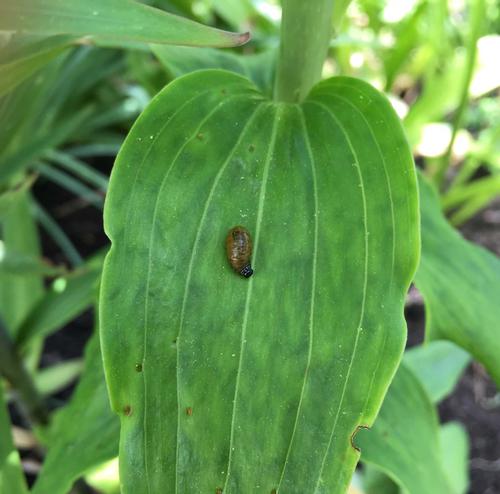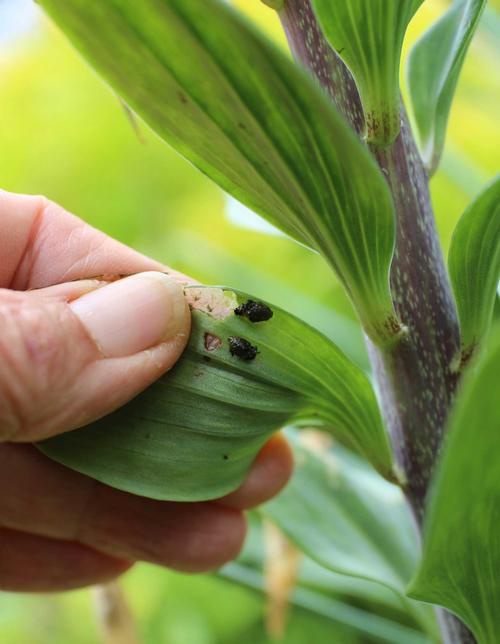
First discovered in Canada about 50 years ago, this non-native species has gradually infiltrated most of New England and central and western Canada. In 2012 it was also discovered in Washington and Oregon.
The beetles are about ¼” long and bright, scarlet red. Though easy to see, they are fast and difficult to catch. If they sense you approaching, they immediately drop to the ground on their backs and quickly vanish into the soil.
There is one generation of lily leaf beetles per year. Adult beetles overwinter in the soil and emerge in April and May to begin feeding and laying eggs. Each female can lay up to 450 eggs over a period of 3 to 4 weeks. These tiny, orange-brown eggs are laid in rows on the underside of lily leaves and the larvae hatch one to two weeks later.
Lily leaf beetle larvae are soft and slug-like (see photo below). They're not pretty, but it gets worse. To protect themselves, they carry their excrement on their backs. Ingenious and super disgusting. (See photo at bottom of page.)

The larvae are voracious eaters and they feed non-stop for 3 to 4 weeks before moving down into the soil to pupate. About a month later they emerge as adult beetles and continue feeding before they return to the soil for the winter.
WHAT TO DO
Most plants can generate new growth if their foliage gets eaten, but that's not the case with lilies. If lily leaf beetles eat the leaves, that's it for the season and the plants may not have enough energy to return the next year. This makes it very important to prevent their damage.
Handpicking. Start scouting for lily beetles in late spring, shortly after your lilies emerge from the ground. You’ll need to sneak up and be prepared to grab them very quickly. Drop into hot soapy water or use force to crush their shells. Inspect stems and leaves from all angles as the beetles hide in leaf crotches.
Destroying this pest’s eggs and larvae is equally important. Check your plants carefully at least twice a week, taking time to bend down and look under every leaf. Scrape off the larvae and remove any eggs. It's an unpleasant task -- wear tight-fitting rubber gloves if you need to.

Spraying. There are two organic sprays that are relatively effective against the red lily leaf beetle. For both, spray coverage must be heavy and complete. Neem, an extract of the neem tree (Azadirachta indica), will kill young larvae. It should be applied every 5-7 days throughout early summer.
Spinosad, an insecticide made from soil bacteria, is also effective if applied weekly whenever the beetles are present. As with all insecticides, it is important to spray only in the evening when bees have finished foraging. Spray only the foliage -- not the flowers -- and avoid spraying in windy weather when the spray may drift onto the flowers. An easy-to-find brand of spinosad is Captain Jack's Deadbug Brew.
In Europe, parasitic wasps keep lily leaf beetle populations in check. Scientists at the University of Rhode Island have released several species of these natural predators in RI, MA, NH and ME. Over time, monitoring has shown that lily leaf beetle populations have declined in most of the test areas and the wasps are gradually spreading into other areas. Hopefully these natural predators will prove to be effective wherever lily leaf beetles are a problem.


